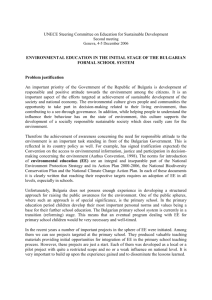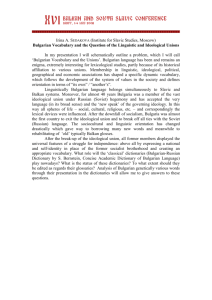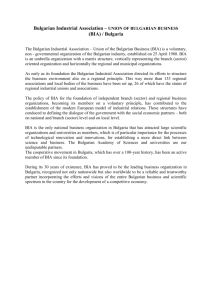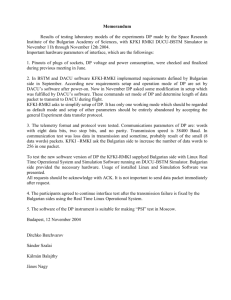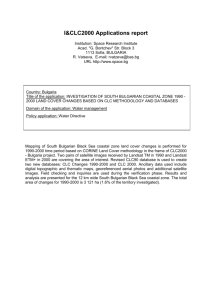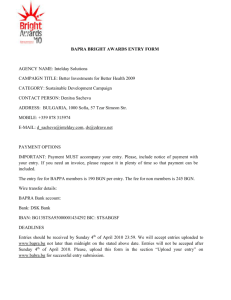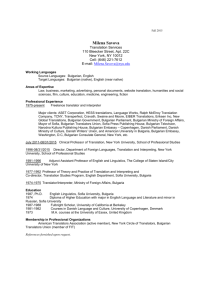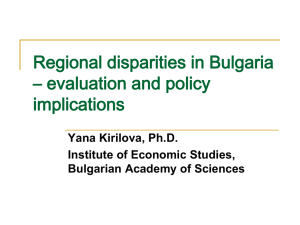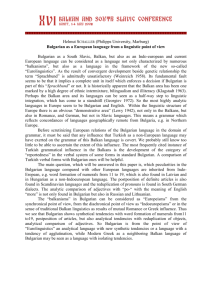WP2 – BULGARIA RESUME
advertisement
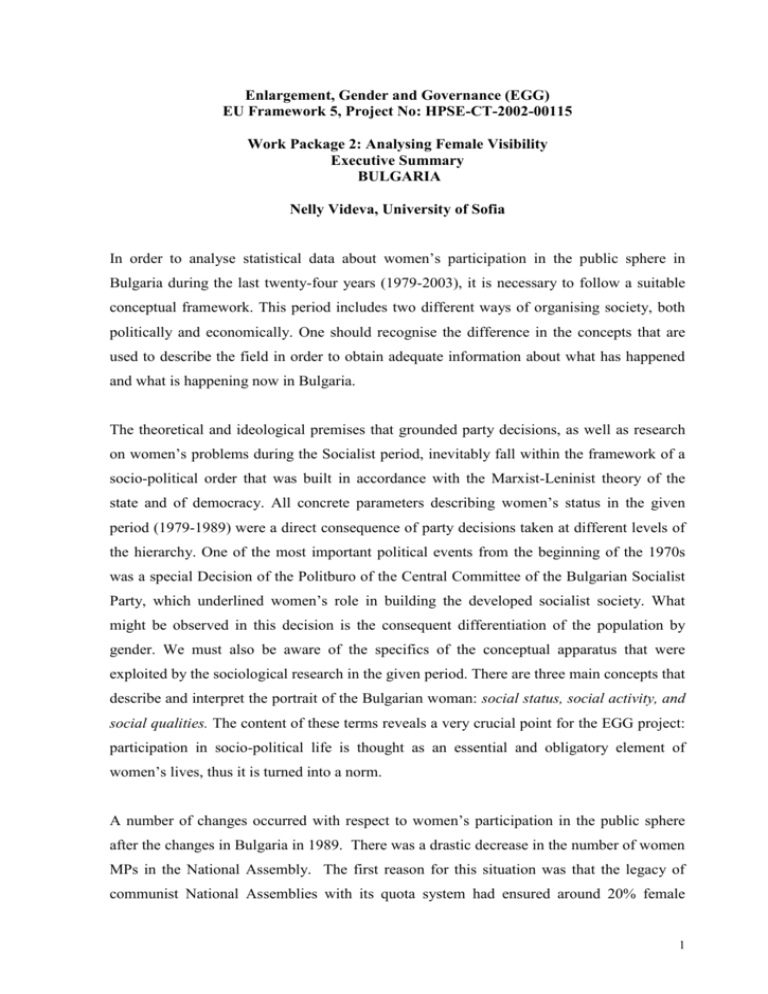
Enlargement, Gender and Governance (EGG) EU Framework 5, Project No: HPSE-CT-2002-00115 Work Package 2: Analysing Female Visibility Executive Summary BULGARIA Nelly Videva, University of Sofia In order to analyse statistical data about women’s participation in the public sphere in Bulgaria during the last twenty-four years (1979-2003), it is necessary to follow a suitable conceptual framework. This period includes two different ways of organising society, both politically and economically. One should recognise the difference in the concepts that are used to describe the field in order to obtain adequate information about what has happened and what is happening now in Bulgaria. The theoretical and ideological premises that grounded party decisions, as well as research on women’s problems during the Socialist period, inevitably fall within the framework of a socio-political order that was built in accordance with the Marxist-Leninist theory of the state and of democracy. All concrete parameters describing women’s status in the given period (1979-1989) were a direct consequence of party decisions taken at different levels of the hierarchy. One of the most important political events from the beginning of the 1970s was a special Decision of the Politburo of the Central Committee of the Bulgarian Socialist Party, which underlined women’s role in building the developed socialist society. What might be observed in this decision is the consequent differentiation of the population by gender. We must also be aware of the specifics of the conceptual apparatus that were exploited by the sociological research in the given period. There are three main concepts that describe and interpret the portrait of the Bulgarian woman: social status, social activity, and social qualities. The content of these terms reveals a very crucial point for the EGG project: participation in socio-political life is thought as an essential and obligatory element of women’s lives, thus it is turned into a norm. A number of changes occurred with respect to women’s participation in the public sphere after the changes in Bulgaria in 1989. There was a drastic decrease in the number of women MPs in the National Assembly. The first reason for this situation was that the legacy of communist National Assemblies with its quota system had ensured around 20% female 1 membership. The second one was the fault of the electoral system itself, which led the National Assembly to reflect internal party politics rather than the attitudes of society at large. As far as the participation of women in the Bulgarian government is concerned, the changes are clearly visible. Before the changes for the whole period (1944-1989) there were only three women appointed as ministers. These female ministers were mainly accepted as representatives of political party structure rather than as members of the government. After 1989, the women who were appointed in Bulgarian governments took a much more active position in them because of the general democratization of society. Some of them held rather prominent positions: for the first time in its history, the country had a woman vice-president, a woman prime minister, and a woman foreign minister. After the recent changes in the present government, Bulgaria has the largest number of women-ministers in its history: 5 out of 22. Women’s involvement in the structure of political parties in Bulgaria can also shed light on the problems that women face when trying to take active part in political life. Before the changes the participation of women in Bulgarian Communist Party was impressive - 29.7%. In spite of this great number, the participation of women in the higher governmental structures remained low. In the period following the changes of ‘89 there was a drastic decrease of women as representatives of political formations. The legacy of the communist past created little public awareness of the need to ensure adequate representation of women. Even though the different parties included women, they tended to place them towards the end of their electoral lists, which meant that women were elected only rarely. However, the situation in the current National Assembly is changing with respect to female members of parliamentary-represented parties. A greater number of women now hold major governing positions such as leaders of parliamentary groups and vice-chairwomen of parties. The “Party of Bulgarian Women” did not have much political impact before it became a coalition partner of the ruling political formation National Movement Simeon II (NDSV). Although a certain level of women’s participation can be observed in another sphere of Bulgarian public life – the judiciary – measures could be made for providing greater career opportunities for female law specialists. The number of women in the Bulgarian Constitutional Court is relatively small. However, in the four mandates of the court there is 2 an increasing number of women judges who occupy such high hierarchical position in the juridical power. The situation is similar in the Supreme Juridical Council, where women come usually from the parliamentarian quota and from the quota of the supreme juridical institutions but never from the Investigation office quota or the quota of the president. The number of women in the Bulgarian Supreme Administrative Court is significant – about 75,8 % of female-judges in the whole institution, and there are chairwomen in three of the five divisions of this court. A reasonable explanation for this can be found in contemporary gender tendencies, which are connected to the status, prestige, and financial benefits of certain jobs over others. The high percentage of women in the administrative juridical power and the low percentage in the other two significant institutions can be viewed in relation to the “feminization of professions”. As far as trade unions are concerned, in the socialist times there was one unified body (Bulgarian Professional Union) that was governed by the Central Committee of the Professional Union. During the pre-89 period there can be detected a stable tendency of engaging more women in local and regional governing structures, while at the same time male members dominated the central governing structures. Another tendency during the period is the traditional engaging of women as presidents of certain branches (usually the Syndicate of teachers or the Syndicate of doctors). In the years after 1989 two trade unions appeared: the Confederation of the Bulgarian Syndicates (CBS) and the Confederation of Labour “Podkrepa” (CL “Podkrepa”). These unions inherited the structure and hierarchies of the Bulgarian Professional Union, and preserved the same basic tendencies of engaging women in the lower governing structures. With respect to the strategies for increasing women’s participation in Bulgaria, it can be said that until now there has been a certain negative attitude - inherited from the past and continuing in the present - regarding the quota principle. However, the project on the Bill of Equal Opportunities, which was created in accordance with EU legislation, is making its way to the parliamentary discussions for the second time in the current parliamentary session. A more detailed and closer interpretation of the possible strategies for change should be based on the analyses of the interviews from the next work packages of EGG. 3
